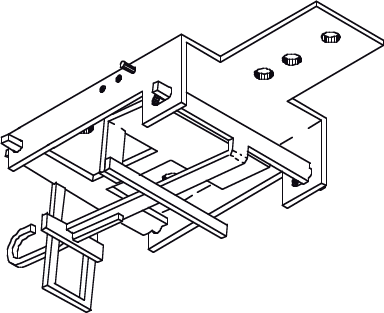Winterley Couplings
The late Rodney Pearce designed this method of coupling for 3mm scale. I saw them at an Exhibition and was fascinated by them. Rodney had needed to make each coupling to match the vehicle he was fitting, and I felt that at least in O gauge it must be possible to produce parts etched in brass that would produce identical couplings each time. I also wanted to try them on my 7mm layout where much shunting is carried out and the operators found the 3 link couplings tedious, especially at exhibitions.
After fitting Winterley Couplings to my stock, and after a little practice of the technique, the operators are able to carry out the shunting moves without ‘the hand of God’ over the layout. The benefit in O gauge is that the hook and 3 links of the existing couplings are still available so that some stock need not have them fitted. One example is a tank wagon with an open chassis; the coupling would be rather unsightly. In O gauge the couplings fit level with the underside of the buffer beam (as shown above) using 10BA bolts as supplied.
The etches in 4mm have been redesigned but work in a similar way. They are designed to replace the Bachmann coupling, although I am aware their design has since changed. I have fitted them to most makes of proprietary wagons, although much of the existing mounting has to be removed (except Bachmann as stated). Kit or scratch-built stock present no problem as the couplings fit to the floor with some packing. Fixing is with 10BA bolts supplied.
A jig is supplied to ensure the level and length on the fixed loop is standard. Vehicles with long buffer shanks need some adjustment to the hook; this is covered in the instructions. A little soldering is required, mainly to strengthen bends in the etches.
Other requirements to help make the couplings work well:
A good controller and smooth running locos help to achieve perfect working of these couplings. It is easier if uncoupling takes place where the operator can see the hooks drop; i.e. use a hand-held controller.
If your stock is very free running, they may couple/uncouple when you least expect it. I find a small piece of foam rubber placed between the floor and one wheel rim is sufficient to stop the problem and will not affect the pulling capabilities of locos with a long train.
I do not recommend shortening the loops too much to close the gap between vehicles. The gap allows for coupling/uncoupling on curves. In O gauge the gap is similar to 3-link, in 4mm the gap closer than the proprietary couplings.
HANDS FREE OPERATION – ANYWHERE!
The Coupling / Uncoupling Action
i). Both vehicles in 'normal mode'.
ii). On approach - the loop passes over the hook and strikes the dropper on part 'B'.
iii). On striking the dropper, the magnet rises and clings to the steel pin under the vehicle, lifting the hook until it meets the loop.
iv). When the vehicles are pulled apart, the hook is captured in the loop. Pulling further pulls the magnet away from the pin. This allows to the hook to drop but as long as the hook and loop are in tension the vehicles remain coupled together.
v). To uncouple - gently move the vehicles together until the hook drops. Then pull apart.
The underside view of the working parts of the 7 mm version. Three of the possible five fixing holes are shown. I recommend fitting with 10BA bolts; some are supplied in the kit. The base plate measures 19mm long by 15mm wide, minimum, after cutting off the tag with the 3 holes shown.
Although the stock needs to remain the right way round to couple with other stock, out and back layouts are not excluded; you only shunt the train when travelling in the correct direction. When running in the wrong direction, treat as a through goods and shunt when the train returns!
In 7mm, I have fitted steam locomotives with both parts, but prefer to fit the fixed loop only, using the screw coupling when necessary. In 4mm, both parts need to be fitted as existing mountings are removed.
REMEMBER THERE ARE NO MAGNETS OR RAMPS WITHIN THE TRACK
Available in kits:
Pack of parts to fit 4 vehicles in 7mm scale: - £14.00
Pack of parts to fit 6 vehicles in 4mm scale: - £11.00
Mail order only. Cheques payable to John Shaw or PayPal (request details).
Post and packing: -
£1.00 for 1 pack,
£2.00 for 2 or more packs.






